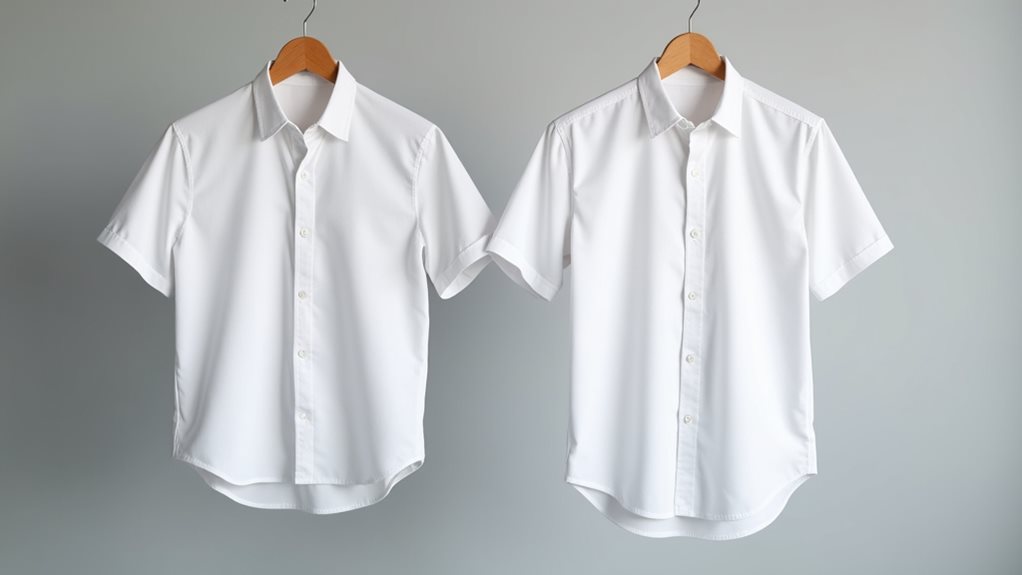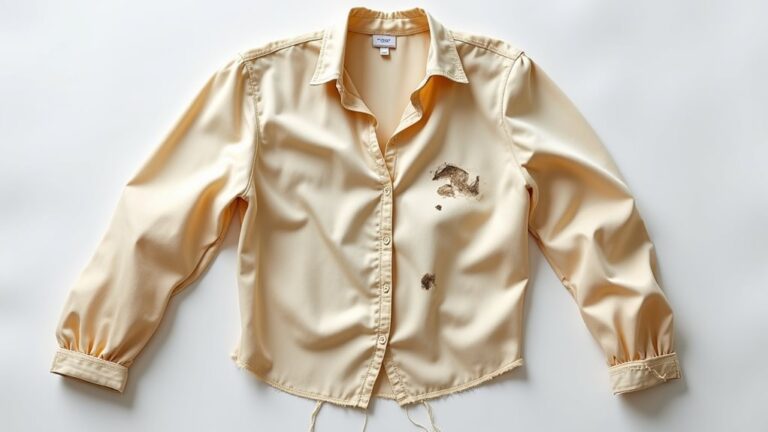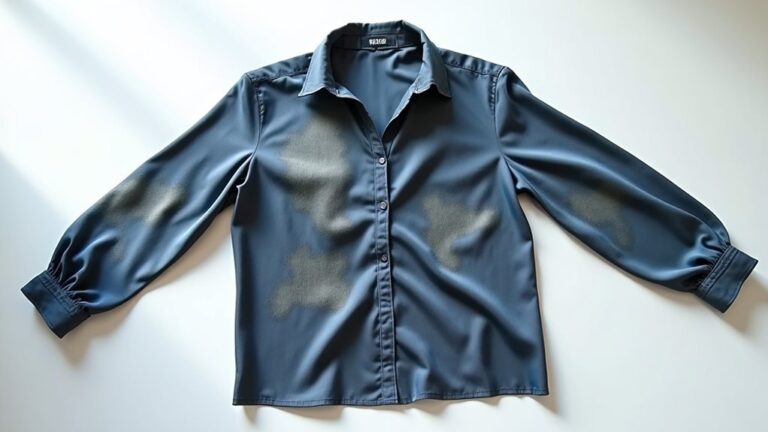While dry cleaning is typically gentler than traditional washing, it can absolutely cause shrinkage when equipment malfunctions or temperatures aren’t properly controlled. You’re safer with dry cleaning than throwing delicate fabrics in your home washer, since the water-free solvents and minimal agitation protect fibers from the heat and moisture that cause contraction. However, faulty machines can expose your clothes to unwanted heat and moisture, leading to that dreaded shrinkage. Understanding the warning signs and choosing reputable cleaners will help you protect your investment pieces.
Understanding the Science Behind Clothing Shrinkage
While you might think fabric shrinkage is some mysterious force that attacks your favorite sweater overnight, it’s actually a fascinating dance between science and unfortunate timing that I’ve witnessed destroy more beloved garments than I care to admit.
Here’s what really happens: your fabrics contain fibers that contract when exposed to heat and moisture during the cleaning process, with natural fibers like cotton and wool being the biggest culprits compared to their synthetic fiber cousins.
The agitation from washing machines adds insult to injury, stressing those poor fibers until they basically give up and shrink.
Washing machines don’t just clean your clothes – they wage war against fabric fibers until surrender becomes inevitable.
That’s why dry cleaning often saves the day – it skips the water drama entirely, protecting your garment from the dreaded shrinkage triangle of heat, moisture, and mechanical stress.
Professional dry cleaners use chemical solvents instead of water, which significantly reduces the risk of shrinkage while still effectively cleaning your delicate garments.
How the Dry Cleaning Process Actually Works

Since I’ve spent countless hours watching my favorite blazer get the royal treatment at my local dry cleaner, I can tell you that the process is surprisingly gentle and methodical compared to the violent spin cycles your washing machine puts clothes through.
When you drop off your garments, they’re first inspected for stains and damage before entering specialized cleaning machines that use a water-free solvent instead of H2O. This dry cleaning process eliminates the main culprit behind shrinkage – water combined with heat and excessive agitation.
During the cleaning cycle, the solvent gently breaks down oils and dirt without causing your fibers to contract or warp. While there’s some tumbling involved, it’s considerably less likely to damage your clothes than traditional washing methods.
After the cleaning cycle, garments undergo solvent extraction and drying, followed by pressing and steaming to restore their original shape and appearance.
Fabric Types and Their Shrinkage Vulnerability
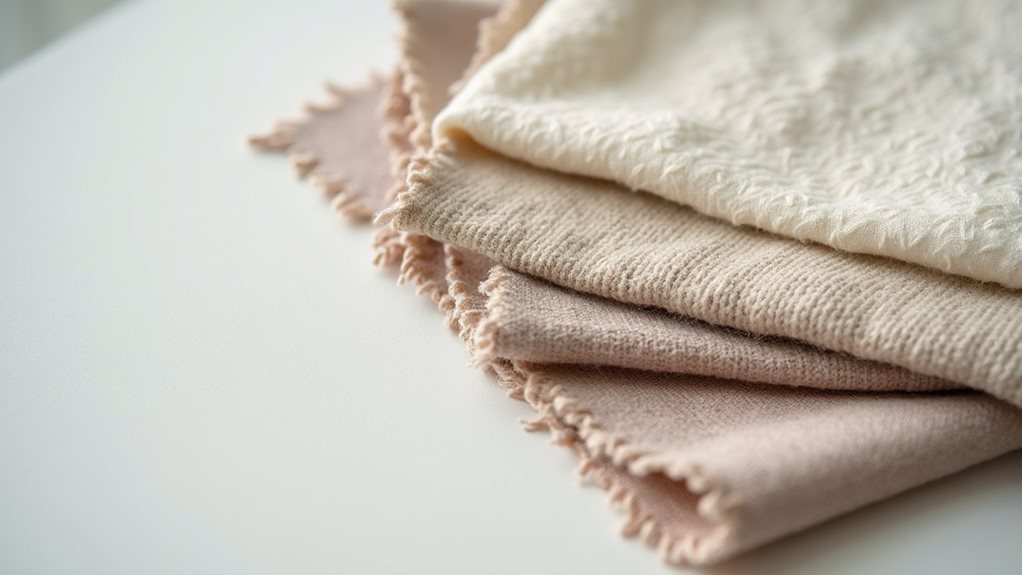
Synthetic fibers such as polyester and nylon, however, resist shrinkage remarkably well, maintaining their shape through multiple cleanings.
You’ll find pre-shrunk garments are your best friends since they’ve already undergone processes to minimize future size changes.
Understanding these fabric types helps you choose appropriate cleaning methods and avoid those heartbreaking moments when your perfectly fitted shirt becomes doll-sized after one unfortunate cleaning mishap.
Dry cleaning uses chemical solvents instead of water and heat, making it gentler on fabrics and helping to preserve the original size and shape of your garments.
Common Myths About Dry Cleaning and Shrinkage
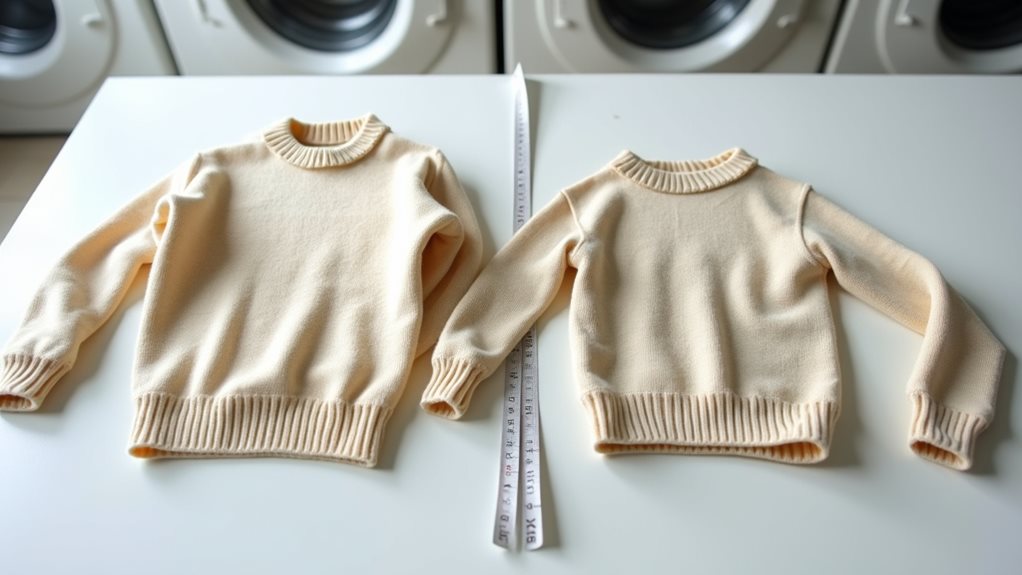
You’ve probably heard someone say that dry cleaning always shrinks clothes, and honestly, I used to believe that myth myself until my favorite wool sweater came back from the cleaners looking exactly the same size it went in.
The truth is, many people assume that because dry cleaning involves professional machinery and chemicals, it must be more aggressive than tossing something in your home washer, but that’s actually backwards thinking.
Another common misconception floating around is that “water-free” automatically means “risk-free,” which isn’t entirely accurate either, though the risks are definitely different from what most people imagine.
Reputable dry cleaners use controlled temperatures and professional-grade equipment specifically designed to preserve your garment’s original shape and size.
Dry Cleaning Always Shrinks
Although countless people swear that dry cleaning automatically means saying goodbye to their favorite outfit’s original size, this widespread belief couldn’t be further from the truth.
You’ve probably heard horror stories from friends about their delicate items coming back smaller, but here’s what’s really happening: dry cleaning uses solvents instead of water, which actually reduces shrinkage compared to traditional washing methods.
Professional dry cleaners understand different fabrics and use specialized techniques that minimize heat and agitation – the real culprits behind shrinkage. While natural fibers can be tricky, skilled cleaners know how to handle them properly.
It’s important to understand that dry cleaning cannot reverse shrinkage that has already occurred during manufacturing processes or previous washing attempts.
The truth is, your garments are often safer with professionals than in your home washer!
Water-Free Means Risk-Free
When I first heard that dry cleaning was “water-free and risk-free,” I believed it wholeheartedly – after all, if there’s no water involved, how could anything possibly go wrong?
However, I quickly learned that while dry cleaning services greatly reduce shrinkage risk, they aren’t completely foolproof.
Yes, the water-free process eliminates the main culprit behind fabric contraction, and professional dry cleaners handle delicate fabrics with expertise that minimizes damage.
Natural fibers like wool and cotton face minimal shrinkage compared to traditional washing methods.
But here’s the thing – some heat and agitation still occur during the cleaning cycle, which means there’s always a slight risk, though it’s markedly lower than home laundering.
Shrinkage can still happen when dry cleaners use improper temperature control or apply aggressive pressing techniques during the finishing process.
When Dry Cleaning Equipment Malfunctions
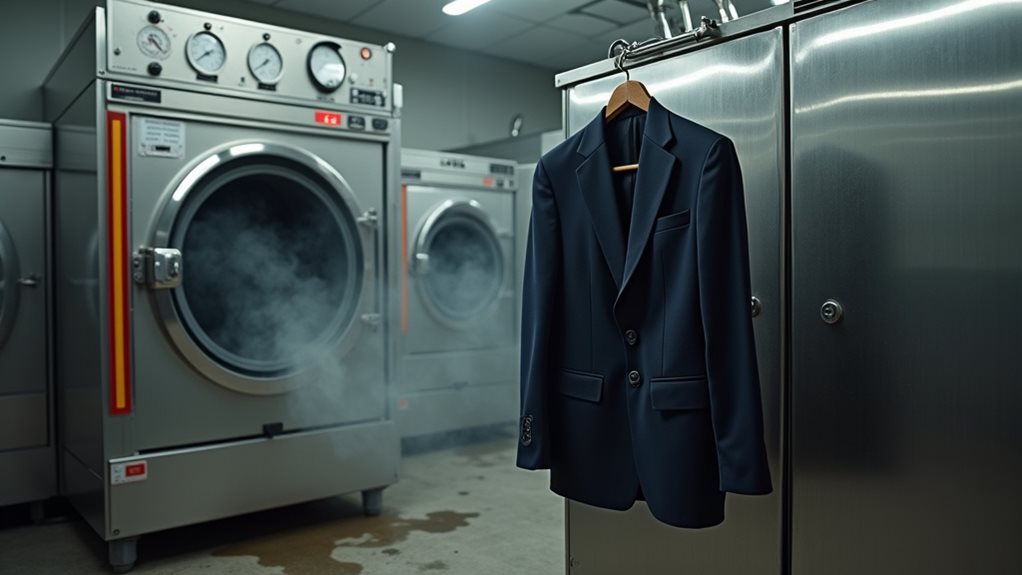
While modern dry cleaning equipment is generally reliable, I’ve learned through years of working with various cleaners that even the best machines can have off days that spell trouble for your favorite garments.
When equipment malfunctions occur, your clothes become vulnerable to the very things dry cleaning should protect them from: heat and moisture exposure that leads to shrinkage.
I’ve witnessed solvent systems fail, allowing water to sneak into the cleaning process and cause unwanted fiber contraction.
Overheating chillers can turn protective solvents into shrinkage-inducing hot baths for delicate fabrics.
Equipment failures can also lead to improper solvent removal, leaving PERC residues on garments that require extended airing time before wearing.
The good news? Professional dry cleaners who prioritize regular maintenance catch these issues quickly, and reputable establishments will stand behind their work when equipment problems damage your clothing.
Comparing Dry Cleaning to Traditional Washing Methods
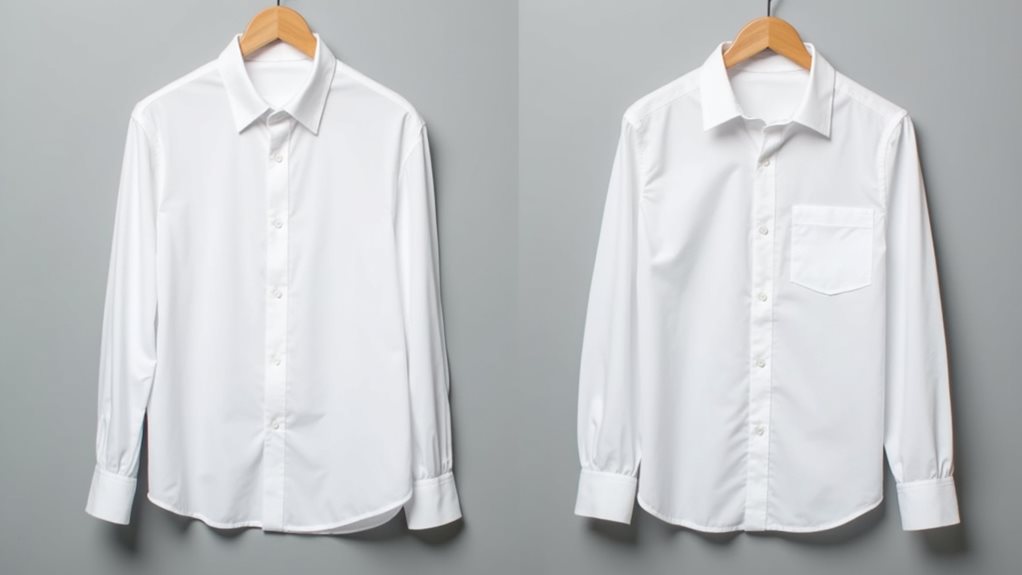
Having spent countless hours rescuing shrunken sweaters from well-meaning but misguided washing machine adventures, I can tell you that the difference between dry cleaning and traditional washing is like comparing a gentle spa treatment to a tumultuous roller coaster ride for your clothes.
Traditional washing throws your garments into a chaotic mix of hot water, aggressive agitation, and mechanical action that natural fibers absolutely despise.
Meanwhile, dry cleaning uses specialized solvents instead of water, eliminating the primary culprit behind shrinkage. The gentle process minimizes the violent tumbling that causes cotton and wool to contract, even when they’re supposedly pre-shrunk.
You’ll find that dry cleaning preserves your garment’s original fit far better than conventional methods.
This is especially important for delicate materials like silk and wool, where chemical solvents provide superior cleaning power without the structural damage that water-based washing inflicts on these sensitive fibers.
Warning Signs Your Dry Cleaner May Be Causing Damage
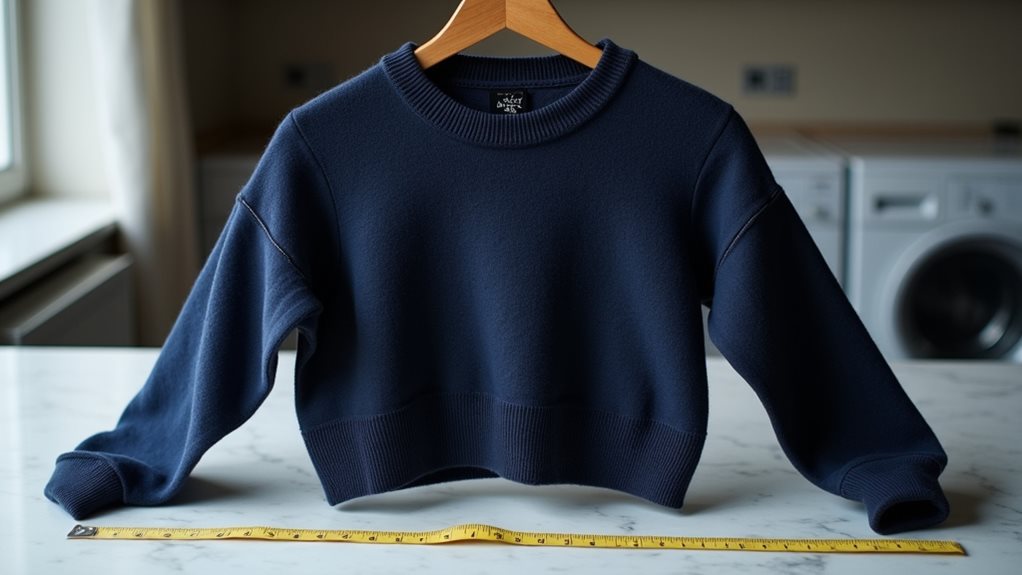
Although dry cleaning should protect your precious garments, I’ve learned the hard way that not all dry cleaners are created equal, and spotting the red flags early can save you from heartbreak and an empty wallet.
Not all dry cleaners are created equal, and spotting red flags early saves heartbreak and money.
When your clothes consistently dry cleaning shrink, it’s screaming that improper techniques or excessive heat exposure are damaging your wardrobe.
Watch for cleaners who skip thorough inspection of clothing before starting the cleaning process – this laziness leads to damaged garments and poor results.
Your delicate fabrics shouldn’t return frayed or faded, and clothes feeling scorching hot are major warning signs.
Additionally, be wary of cleaners still using perchloroethylene (PERC) as their primary solvent, since this chemical has been classified as a probable human carcinogen by health agencies.
I always check customer reviews for mentions of shrinkage issues before trusting any cleaner, because finding a trustworthy dry cleaner requires doing your homework first!
Best Practices to Protect Your Garments From Shrinkage

Since discovering that my favorite cashmere sweater had transformed into what could generously be called “doll clothes” after one disastrous dry cleaning experience, I’ve become somewhat obsessed with protecting my garments from shrinkage.
Trust me, the strategies I’ve learned through trial and error can save you from similar fashion heartbreak. Heat causes most fabric disasters, so choosing professional dry cleaners who understand delicate fabrics makes all the difference in garment care.
Here’s what I’ve learned to minimize risk:
- Always check washing instructions before any cleaning method, whether you’re using a gentle cycle at home or heading to dry cleaning.
- Invest in pre-shrunk clothing when possible, as these garments won’t surprise you later.
- Store everything properly—hanging or laying flat prevents unnecessary fiber stress that weakens fabric integrity.
- Communicate with your dry cleaner about any special care requirements, as aggressive mechanical action during the cleaning process can damage fabric structure and lead to unwanted dimensional changes.

